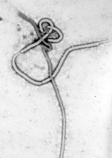Ebola pox
The Ebola smallpox (English: "Ebolapox") are alleged infectious disease caused by a modified variant of the poxvirus, a genetically engineered hybrids from the Ebola virus and smallpox virus is to be caused. The virus is said to have been developed as a bioweapon as part of the Biopreparat project in the Soviet Union until the 1990s.
Background and pathogen

|

|
|
|
Left: Ebola virus , right: Smallpox virus
|
||
Ebola pox is a potential hybrid form of smallpox that is said to have been created by inserting Ebolagenes into the genome of smallpox, which is said to have combined properties of the Ebola virus with those of the smallpox virus.
There are several naturally occurring strains of the smallpox virus ( Orthopoxvirus variola ), which differ significantly in their properties and symptoms. The most common strains of naturally occurring smallpox have a mortality rate of 30-50%. The mortality rate from untreated Ebola virus diseases is 70-90%. The Ebola virus carries its genetic code in the form of the molecule RNA , while smallpox has DNA . According to Russian scientist Kanachan Alibekov , better known as Ken Alibek, Soviet researchers were working on using reverse transcriptase to make a DNA copy of the disease-causing parts of the Ebola genome, which was then transferred into smallpox pathogens. These are probably the surface protein types GP and sGP, by means of which the virus attaches itself to a receptor on the target cell and initiates endocytosis in the subsequently infected cell. According to Alibek, the resulting hybrid viruses should be stable.
The aim of hybridization was to create a strain of smallpox that always caused purpura smallpox or "black pox", the hemorrhagic form of the disease that in most cases leads to death within seven days of infection. This form does not lead to the typical smallpox formation in the form of blisters on the skin, but to hemorrhagic bleeding under the skin due to blood escaping from the veins, which causes the skin to turn purple or black. The combination of the two viruses would therefore combine the hemorrhagic effects of both diseases as well as the potentially easier infection of the smallpox virus through airborne transmission. This combination would create a virus that causes almost 100% mortality, for which there is also no currently known, effective antidote.
Transmission and history
The strain used to manufacture weapons after 1967, when applied as an aerosol , is said to have induced purpura smallpox within one to five days in exposed monkeys.
history
In the mid-1980s, the Soviet biopreparation project began to process the Ebola virus for bioweapons. The virus was bred and treated in such a way that it became stable, transportable, less sensitive to fluctuations in temperature and humidity, and remained infectious for a long time after nebulization. For this purpose, animal experiments were carried out with the help of primates, the results of which could only be used to a limited extent. The Soviet scientists are also said to have collected experience reports from doctors who had experience with the Ebola virus especially in Africa .

Ken Alibek, who fled to the United States in October 1992, said that during the global campaign to eradicate smallpox, samples of smallpox were taken by Russian doctors and made weaponized on behalf of the Soviet military. The Russians themselves had proposed the global eradication program in 1958, according to Alibek, with the aim of making smallpox "the most powerful and effective weapon of all time" when it was officially eradicated and vaccinations ended.
Two particularly virulent strains of smallpox, India 67 and India 1 , have been selected by Russian scientists to become the basis of their biological weapons and also of Ebola pox.
doubt
Although research on both the Ebola virus and different strains of smallpox pathogens is said to have been documented, according to a research group such a hybrid virus was not actually developed in the Soviet Union as part of the so-called "Hunter program" and the corresponding information was incorrect. There are reports on various attempts to provide the vaccinia virus with individual Ebola genes, genes for immunoregulatory substances and endogenous proteins such as myelin , the aim of which should be to induce severe autoimmune diseases; Such attempts had not progressed far enough when the Soviet Union collapsed to be suitable for the use of weapons.
literature
- Richard C. Shelby: Biological Weapons: The Threat Posed by Terrorists - Congressional Hearing. Diane Publishing, 2000, ISBN 0-16-057759-4 .
- Thomas Preston: From Lambs to Lions: Future Security Relationships in a World of Biological and Nuclear Weapons. Rowman & Littlefield Publishers, 2007, ISBN 978-0-7425-5503-7 .
- Sharad S. Chauhan: Biological Weapons. APH Publishing, 2004, ISBN 81-7648-732-5 .
Web links
- Smallpox, plague and Ebola as perfidious biological weapons. Interview with Ken Alibek about Ebola pox, among others. on: welt.de
- ( Page no longer available , search in web archives: ANNALS OF WARFARE - THE BIOWEAPONEERS (English) )
Individual evidence
- ↑ a b c d e f Geoffrey Zubay: Agents of Bioterrorism: Pathogens and Their Weaponization. Columbia University Press, 2012, pp. 73-74. ( Google Books )
- ↑ Philip Bethge: Construction kit for horror germs . In: Der Spiegel. 43/2001; accessed on September 14, 2015.
- ^ A b Thomas Preston: From Lambs to Lions: Future Security Relationships in a World of Biological and Nuclear Weapons. 2007, ISBN 978-0-7425-5503-7 , p. 304.
- ↑ a b Smallpox, plague and Ebola as perfidious biological weapons. In: The world. May 9, 2000.
- ↑ Russia has made Ebola a weapon. In: The world. August 21, 2014.
- ^ A b Silent Weapon: Smallpox and Biological Warfare. on: BBC History. February 17, 2011. (English)
- ^ Milton Leitenberg, Raymond A. Zilinskas, Jens H. Kuhn: The Soviet Biological Weapons Program: a history. Harvard University Press, 2012, ISBN 978-0-674-06526-0 , pp.?.